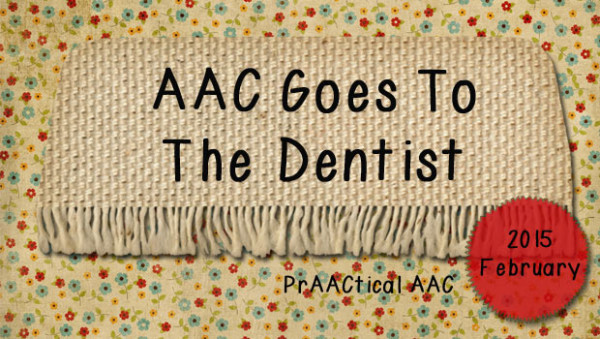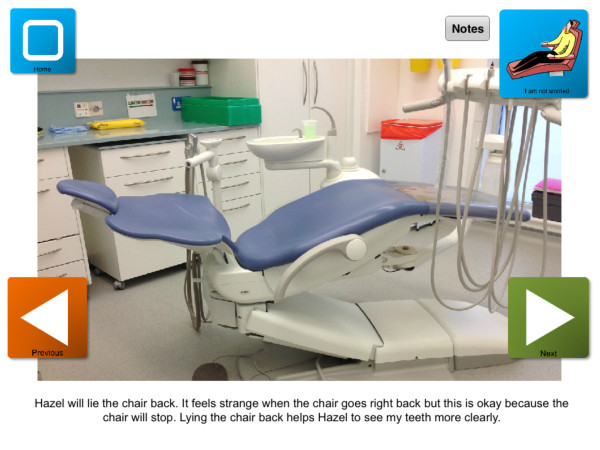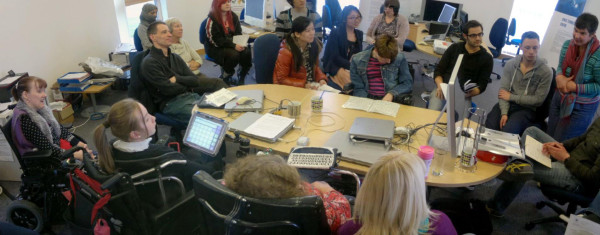AAC Goes to the Dentist

If you are among those who believe that AAC is a 24/7 proposition, then, like us, you may be looking for ways that we SLPs can better support our clients in the community. Like the rest of us, our AAC clients want and need to be active participants in their healthcare, and we can play an important role in helping them build the receptive and expressive communication skills to be more successful in that. In today’s post, we hear from Dr. Rachel Menzies (Email: r.menzies@dundee.ac.uk) from the AAC Research Group in the School of Computing at the University of Dundee. Dr. Menzies shares ways in which her team is developing social narratives around visiting the dentist.
I’ve never been a fan of going to the dentist, but I am lucky. I have the cognitive capacity and understanding to consider the consequences of NOT going to the dentist and to regulate my emotions when I DO go. For those with intellectual difficulties or conditions such as Autism, a visit to the dentist can be an insurmountable challenge (despite AAC provisions) and can result in meltdowns, emotional distress and the use of general anaesthetic for the most basic treatments. The reason for all of this: difficulties in communicating emotions and asking questions of dental staff. If we can solve, or at least support, these challenges then the implications for dental health are massive. The Stories at the Dentist application is a step in the right direction towards autonomous healthcare for individuals with disabilities.

AAC technologies to support individuals with Autism are a mainstay of the research carried out in the AAC Research Group at the University of Dundee. Previous projects have included ECHOES[1], a large multi-centre study to investigate the design of technology for developing social skills and CHAMPION[2], a passport style application for communication between patients and healthcare professionals in a hospital setting. The research conducted is extremely applied and relevant to real life, because individuals with severe speech and physical impairments make up an on-site user group that meets regularly, while the team has strong links with local education authorities. This ensures that any new technologies are tested “in the wild”, in real life situations, with real life problems.
A main goal of the AAC Research group is to create technology that allows independence, including generating novel speech, such as the Phonic Stick[3], and inclusion in decision-making. The Stories at the Dentist application helps patients to understand the content of a dental consultation and allows them opportunities to put forward their wishes and opinions. The dentists who have used the app have commented on the reduced anxiety in their patients and the value of knowing that their patients have concerned, which can be addressed with further consultation. This involvement of dental staff has been crucial to the development of this app – it was developed in a clinical setting and designed by clinicians using a user-centred methodology[4]. This methodology is central to all technologies developed by the group.

The application is based on social stories[5] and follows principles laid out in research by Carol Gray, ensuring that the information is presented in a meaningful way to patients before they visit a dental setting.
A clinician gathers information about a patient appointment and a social story is created based on a template. The information about the upcoming appointment is then presented to students in a multi-modal format that allows for the app to be used by individuals with different disabilities. Sentences are short and an image is displayed to aid comprehension. The sentences can also be read aloud by the app if desired. Users can move through the story by swiping to the left (as if reading a book) or by pressing the arrows at either side of the screen. The story can also be shown to patients in a booklet form, to prepare them for their visit. The booklet form can be given to patients who need additional support, so that they can refer to the story at any time in the lead up to the appointment. In most cases, the users who will have most benefit from this application do not own an iPad and so it is presented to them during clinical or social appointment. That being said, many technologies are becoming more mainstream with the introduction of cost effective applications such as Proloquo2Go[6] being readily available on iPads and other tablets.
Stories at the Dentist is currently a research tool and is not available on app store as yet. Contact Prof. Annalu Waller (a.waller@dundee.ac.uk) for more information.
Links
[2] http://aac.computing.dundee.ac.uk/champion
[3] http://phonicstick.computing.dundee.ac.uk/
[4] http://www.w3.org/WAI/redesign/ucd
[5] http://www.haringey.gov.uk/what_are_social_stories.pdf
[6] http://www.assistiveware.com/product/proloquo2go
Filed under: PrAACtical Thinking
This post was written by Carole Zangari

5 Comments
Keep on blogging good materials, very helpful.
I have clearly understand about the AAC goes to the dentist topic, you’ve give one of the best articles for this one. Now it is known to me that articles is nothing but inspiring is everything to do something great.
I love the goals of the AAC, such a great program, much appreciated!
Useful post thanks for sharing
Excellent post.